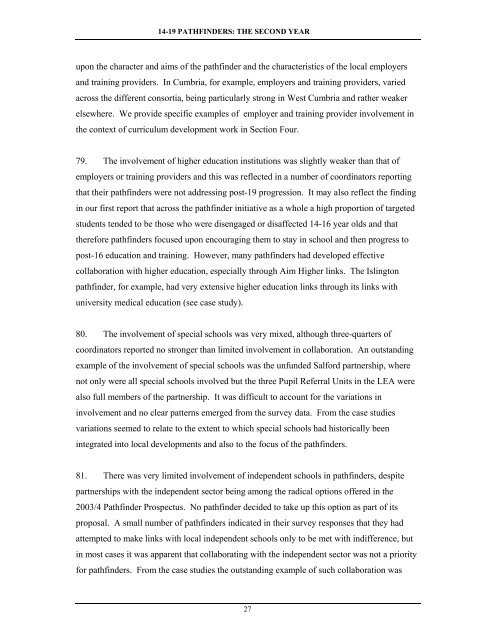Collaborative Approaches to 14-19 Provision - Communities and ...
Collaborative Approaches to 14-19 Provision - Communities and ...
Collaborative Approaches to 14-19 Provision - Communities and ...
- No tags were found...
You also want an ePaper? Increase the reach of your titles
YUMPU automatically turns print PDFs into web optimized ePapers that Google loves.
<strong>14</strong>-<strong>19</strong> PATHFINDERS: THE SECOND YEARupon the character <strong>and</strong> aims of the pathfinder <strong>and</strong> the characteristics of the local employers<strong>and</strong> training providers. In Cumbria, for example, employers <strong>and</strong> training providers, variedacross the different consortia, being particularly strong in West Cumbria <strong>and</strong> rather weakerelsewhere. We provide specific examples of employer <strong>and</strong> training provider involvement inthe context of curriculum development work in Section Four.79. The involvement of higher education institutions was slightly weaker than that ofemployers or training providers <strong>and</strong> this was reflected in a number of coordina<strong>to</strong>rs reportingthat their pathfinders were not addressing post-<strong>19</strong> progression. It may also reflect the findingin our first report that across the pathfinder initiative as a whole a high proportion of targetedstudents tended <strong>to</strong> be those who were disengaged or disaffected <strong>14</strong>-16 year olds <strong>and</strong> thattherefore pathfinders focused upon encouraging them <strong>to</strong> stay in school <strong>and</strong> then progress <strong>to</strong>post-16 education <strong>and</strong> training. However, many pathfinders had developed effectivecollaboration with higher education, especially through Aim Higher links. The Isling<strong>to</strong>npathfinder, for example, had very extensive higher education links through its links withuniversity medical education (see case study).80. The involvement of special schools was very mixed, although three-quarters ofcoordina<strong>to</strong>rs reported no stronger than limited involvement in collaboration. An outst<strong>and</strong>ingexample of the involvement of special schools was the unfunded Salford partnership, wherenot only were all special schools involved but the three Pupil Referral Units in the LEA werealso full members of the partnership. It was difficult <strong>to</strong> account for the variations ininvolvement <strong>and</strong> no clear patterns emerged from the survey data. From the case studiesvariations seemed <strong>to</strong> relate <strong>to</strong> the extent <strong>to</strong> which special schools had his<strong>to</strong>rically beenintegrated in<strong>to</strong> local developments <strong>and</strong> also <strong>to</strong> the focus of the pathfinders.81. There was very limited involvement of independent schools in pathfinders, despitepartnerships with the independent sec<strong>to</strong>r being among the radical options offered in the2003/4 Pathfinder Prospectus. No pathfinder decided <strong>to</strong> take up this option as part of itsproposal. A small number of pathfinders indicated in their survey responses that they hadattempted <strong>to</strong> make links with local independent schools only <strong>to</strong> be met with indifference, butin most cases it was apparent that collaborating with the independent sec<strong>to</strong>r was not a priorityfor pathfinders. From the case studies the outst<strong>and</strong>ing example of such collaboration was27
















